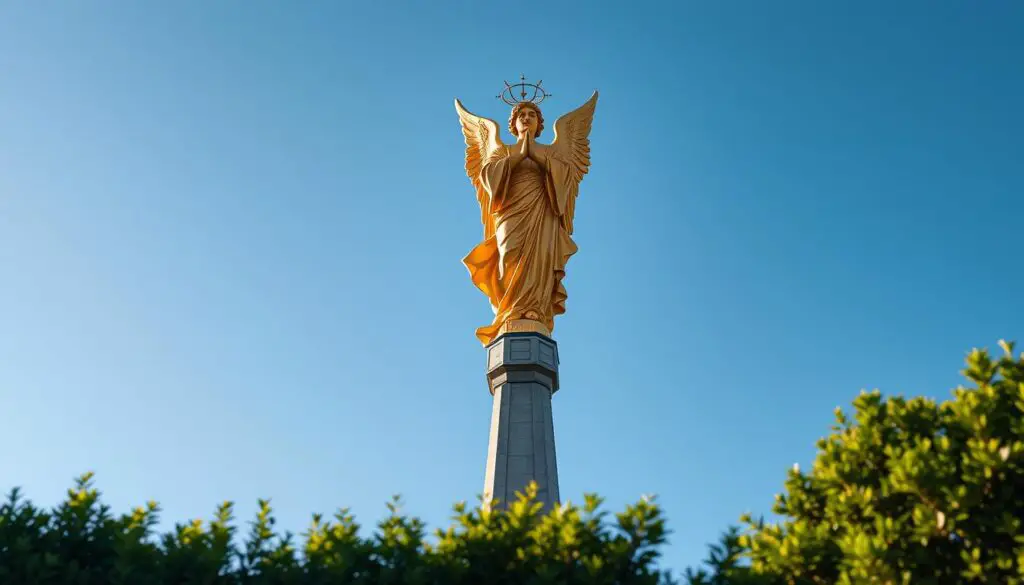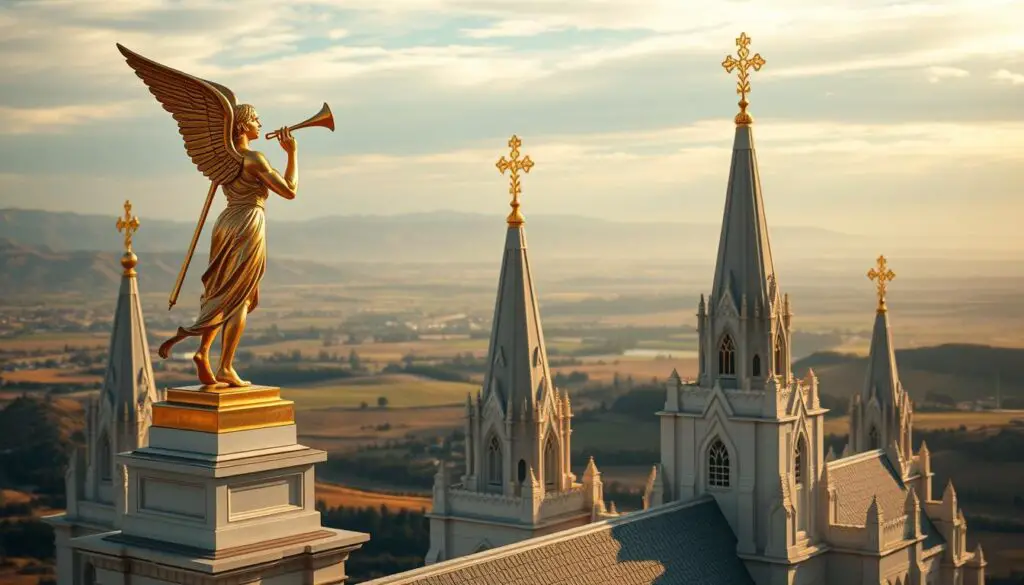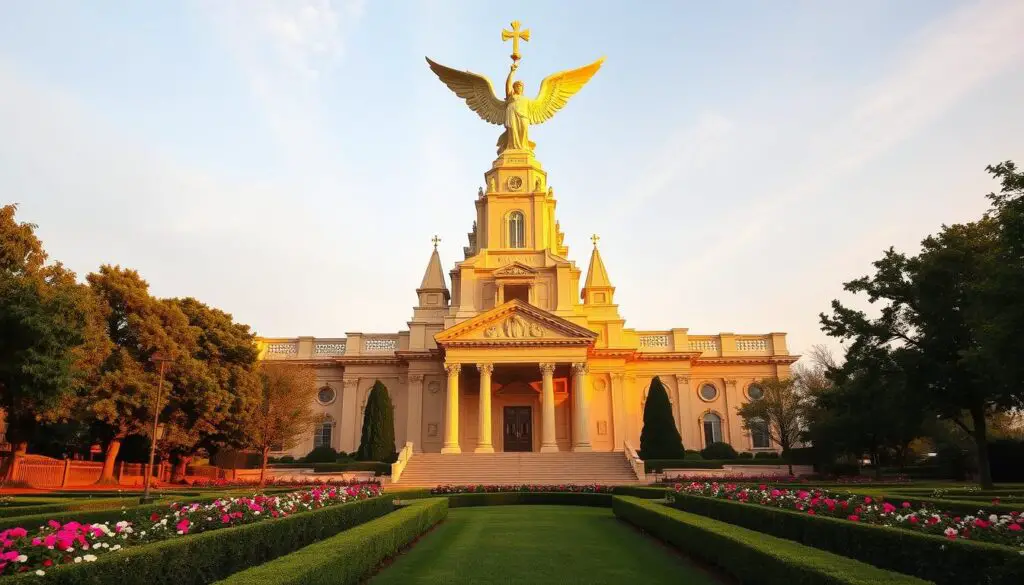High atop temples across the globe, a golden figure stands as a symbol of faith and resilience. This iconic representation, often mistaken for simple decoration, carries a story woven into the fabric of religious history. Its journey began humbly as a weathervane on the Nauvoo Temple, evolving into a powerful emblem recognized worldwide.
The figure’s design reflects both spiritual vision and artistic innovation. Early depictions were functional, guiding pioneers through storms. Over time, artists like Cyrus Dallin transformed it into a masterpiece, blending sacred symbolism with architectural grandeur. The Salt Lake Temple’s version became a blueprint for future interpretations, merging tradition with evolving craftsmanship.
This symbol isn’t just metal and gold leaf—it’s a bridge between past and present. From Joseph Smith’s reported visions to modern-day temple spires, it represents continuity in belief. Each detail, from the trumpet’s angle to the flowing robes, whispers tales of devotion and cultural adaptation.
Key Takeaways
- The iconic figure originated as a practical weathervane before becoming a spiritual symbol.
- Artists like Cyrus Dallin shaped its modern artistic interpretation during the late 19th century.
- Salt Lake City’s temple design set the standard for global architectural adaptations.
- Its imagery blends religious meaning with historical craftsmanship trends.
- The symbol continues to unite communities through shared heritage and visual storytelling.
Introduction: Exploring a Sacred Legacy
What began as a simple directional tool transformed into a beacon of faith across continents. The figure’s story intertwines craftsmanship with spiritual vision, evolving from modest beginnings to a globally recognized emblem. Its journey mirrors the growth of a community’s identity, shaped by both necessity and reverence.
An Overview of the Mormon Angel Mythos
Early depictions served practical purposes, like guiding pioneers through harsh weather as temple weathervanes. Over time, these functional designs gained deeper meaning. The hand clutching a trumpet came to symbolize divine messages, while gold leaf applications reflected sacred value. Artists reinterpreted the form, blending scriptural references with evolving architectural styles.
Purpose and Relevance in Latter-day Saint Culture
This symbol unites communities through shared history and visual storytelling. Gold’s use isn’t merely decorative—it echoes themes of enlightenment and eternal promises. As one historian noted,
“The statue’s upward gaze reminds believers of aspirations beyond the earthly realm.”
Today, it bridges generations, appearing on temples worldwide as a testament to enduring faith.
From weather-resistant copper to gleaming modern alloys, materials evolved while core symbolism remained. Each detail—the angle of the trumpet or folds in robes—carries intentional meaning. This fusion of art and theology continues to inspire, making the figure a cornerstone of cultural heritage.
Origins and Early Depictions
In 1840s Illinois, a copper weathervane shaped like a heavenly messenger became the seed of an enduring tradition. This functional artwork crowned the Nauvoo Temple spire, serving both practical and symbolic purposes during America’s westward expansion.

The Practical Beginnings in Nauvoo
Architects of the era often used weathervanes featuring patriotic eagles or mythological figures. The Nauvoo design broke tradition by depicting a trumpet-bearing messenger. Historical records show:
| Feature | Nauvoo Original | Modern Versions |
|---|---|---|
| Material | Copper sheeting | Gold-leafed fiberglass |
| Function | Wind direction | Spiritual landmark |
| Height | 6 feet | Up to 18 feet |
Visions That Shaped a Symbol
Early Latter-day Saint accounts describe profound spiritual experiences that transformed this architectural element. A community leader once reflected:
“The figure became more than metal—it represented divine guidance through turbulent times.”
These foundational stories explain why the weathervane evolved into statues gracing temples angel Moroni worldwide. From its humble start in Nauvoo to the iconic Salt Lake City prototype, each iteration carries echoes of its practical origins.
The Evolution from Weathervane to Statue
Nineteenth-century America witnessed a dramatic shift in architectural expression. Public buildings began favoring grand statues over functional weathervanes, reflecting a cultural hunger for permanence. This transformation reshaped religious structures too, including those of the Church of Jesus Christ of Latter-day Saints.
Shifts in Architectural Trends in 19th Century America
By the 1880s, neoclassical designs dominated civic architecture. Courthouses and libraries adopted marble figures to convey authority and timelessness. Religious leaders noticed this trend, recognizing statues as powerful symbols for sacred spaces.
The original Nauvoo weathervane—a practical copper creation—evolved into stationary statues during this era. Architects argued that fixed figures better represented enduring spiritual truths. As one journal from 1892 states:
“Monumental art speaks to eternity, not just the shifting winds.”
This pivot allowed the Jesus Christ of Latter-day Saints community to maintain angelic symbolism while aligning with modern aesthetics. The Moroni statue emerged as a bridge between tradition and innovation, its trumpet now pointing heavenward rather than indicating wind direction.
Key factors driving this change included:
- Urbanization’s demand for visually striking landmarks
- The influence of European sculptural traditions
- A desire to showcase theological continuity through art
Today, these statues remain central to temple architecture, their golden forms echoing both sacred purpose and 19th-century design sensibilities.
Influence of Architecture on Angelic Imagery
America’s 19th-century architectural renaissance didn’t just shape skylines—it reshaped sacred symbolism. As cities erected grand courthouses and libraries, religious communities drew inspiration from these secular marvels. The latter-day saint tradition embraced this trend, transforming civic design elements into spiritual statements.

From Public Building Trends to Sacred Symbols
Neoclassical columns and marble statues became hallmarks of civic pride during this era. Architects borrowed these motifs for religious structures, blending earthly grandeur with heavenly themes. A striking example appears in early temple designs, where trumpet-bearing figures mirrored the authoritative poses of secular monuments.
Consider these comparisons between public and sacred architecture:
| Feature | Secular Buildings | Religious Symbols |
|---|---|---|
| Materials | Marble, bronze | Gold leaf, copper |
| Design Motifs | Eagles, liberty caps | Trumpets, scrolls |
| Purpose | Convey authority | Signify divine messages |
Joseph Smith’s vision for communal spaces emphasized unity between earthly and eternal ideals. As one historian observed:
“Temples became canvases where faith met the architectural language of the age.”
This fusion strengthened community identity. Gold-leafed statues, once limited to government buildings, now crowned temples as beacons of hope. Through these adaptations, the latter-day saint tradition wove itself into America’s cultural tapestry while honoring its unique theological roots.
The Role of Cyrus Dallin and Early Sculptures
A Boston sculptor’s quiet hesitation became the catalyst for one of religious art’s most recognizable figures. When approached by the Church of Jesus Christ of Latter-day Saints in 1891, Cyrus Dallin initially declined the commission. Family encouragement ultimately swayed him, leading to a creation that redefined sacred architecture.
Cyrus Dallin’s Masterpiece and Its Impact
Dallin’s 12-foot statue blended neoclassical precision with spiritual symbolism. His training under Parisian masters shone through in the figure’s dynamic posture and flowing robes. Though he originally labeled the work “Angel Gabriel,” church leaders reinterpreted it as Moroni—a pivotal figure in Latter-day Saint teachings.
This renaming marked a turning point in church history. As one art historian noted:
“The shift from Gabriel to Moroni transformed the statue from generic messenger to specific theological anchor.”
The Transition from Gabriel to Moroni
Dallin’s design became the blueprint for future temple statues. Its raised trumpet and westward gaze inspired adaptations in Los Angeles and beyond. The sculptor’s initial resistance faded as his work gained prominence, proving that art could shape religious identity.
Key aspects of Dallin’s legacy include:
- Blending European artistry with American religious themes
- Establishing visual continuity across global temples
- Demonstrating how artistic interpretation influences doctrinal expression
Iconography and Symbolism in Latter-day Saint Temples
Sacred architecture tells stories through stone and symbolism. In Church of Jesus Christ temples, every detail whispers of spiritual truths—from celestial motifs to the iconic gold plates etched into designs. These elements aren’t decorations but doctrinal declarations in physical form.
The gold plates motif appears repeatedly, symbolizing divine revelation and scriptural foundations. Early leader Wilford Woodruff emphasized their importance, stating:
“These symbols anchor us to sacred history while pointing toward eternal promises.”
Salt Lake City’s temple showcases this best. Its east-facing doors feature engraved gold plates, mirroring accounts of ancient records. Similarly, the Lake City spire integrates wheat sheaves and compass stars—emblems of spiritual nourishment and divine guidance.
Modern temples continue this tradition. Architects blend classic symbols with contemporary materials, ensuring relevance without losing meaning. A Church of Jesus Christ design committee member recently noted:
“Our symbols must speak across generations, just as they did for Wilford Woodruff’s era.”
From Salt Lake City to smaller communities like Lake City, these visual elements unite believers. They transform stone and metal into silent sermons, preserving legacy while inviting personal reflection.
The Enduring Legacy of the Mormon Angel
Golden spires crowned with celestial figures have become silent storytellers across generations. These statues anchor sacred spaces while reflecting evolving artistic traditions, creating visual continuity from pioneer-era temples to modern worship centers.

Unifying Themes in Temple Architecture
Designers maintain core symbolic elements while adapting to local contexts. The Nauvoo Temple’s original weathervane inspired standardized features seen today:
- Upward-facing trumpets signaling spiritual awakening
- Gold finishes representing divine light
- Eastward orientation mirroring scriptural prophecies
A Church of Jesus Christ Latter-day architect explains:
“Our temples speak a shared visual language—the statue serves as its exclamation point.”
How the Angel Became a Symbol of Restoration
The figure’s connection to religious renewal traces back to early 19th-century teachings. Its presence on the rebuilt Nauvoo Temple in 2002 symbolically healed historical fractures, blending past and present through art.
Modern adaptations showcase this continuity:
| Era | Material | Symbolic Focus |
|---|---|---|
| 1840s | Copper | Practical guidance |
| 2020s | Fiberglass/gold leaf | Eternal promises |
This evolution demonstrates how a simple statue became shorthand for the Church of Jesus Christ Latter-day Saints’ journey—from frontier perseverance to global presence.
Modern Interpretations and Variations
Modern technology breathes new life into sacred symbols while honoring centuries-old traditions. Architects now blend cutting-edge materials with timeless spiritual motifs, creating statues that withstand both time and weather. This fusion ensures symbols remain relevant across cultures without losing their heavenly essence.

Innovations in Material and Design
Fiberglass revolutionized temple art by replacing heavy bronze with lightweight durability. These modern statues weigh 80% less than their predecessors, simplifying installation on towering spires. A Church architect explained:
“Gold leaf over fiberglass lets us maintain brilliance while adapting to local climates—from tropical humidity to alpine winters.”
Key design shifts include:
- Smoother surfaces resisting corrosion
- Modular construction for global shipping
- Customizable sizes fitting diverse temple heights
Global Adaptations in New Temple Constructions
From Manila to Rome, modern materials help statues harmonize with regional architecture. The Philippines’ temple features a 12-foot figure with reinforced fiberglass to withstand monsoon rains. Meanwhile, Ghana’s design incorporates locally sourced gold leaf, connecting earthly resources to heavenly themes.
| Location | Material Innovation | Cultural Adaptation |
|---|---|---|
| Rome, Italy | UV-resistant coatings | Classical pose mirroring Roman statuary |
| Tokyo, Japan | Seismic-resistant base | Subtle gold tones complementing minimalist aesthetics |
These innovations prove sacred symbols can evolve without sacrificing meaning. As temples multiply worldwide, their spires continue pointing toward heaven, united by tradition yet distinct in local expression.
Cultural and Theological Significance
Sacred symbols often bridge communities and beliefs, becoming woven into daily life. The golden figure atop temples serves this role, evolving from architectural detail to theological touchstone. Its imagery now permeates Latter-day Saint art, media, and personal devotion.
Influence on LDS Art and Media
From stained glass to children’s books, the figure appears as a visual shorthand for divine connection. Artists often pair it with plates symbolizing ancient records, reinforcing scriptural foundations. A Church art curator observed:
“These motifs remind people of their spiritual roots while inviting fresh interpretations.”
Films and hymns reference the symbol to illustrate themes of revelation. Its upward gaze frequently represents hope in eternal life, resonating deeply during milestones like births or memorials. For many, seeing it in media reinforces personal faith journeys.
The symbol’s design draws from biblical visions like Revelation’s trumpet-bearing messengers. This links modern worship to ancient prophecies, creating continuity across generations. Materials like gold leaf echo scriptural descriptions of heavenly realms, turning temples into three-dimensional sermons.
Four ways it shapes daily life:
- Home decor featuring stylized trumpet motifs
- Youth curriculum using the image to teach resilience
- Memorial jewelry symbolizing loved ones’ eternal life
- Community art projects celebrating shared values
As a top emblem in Church iconography, it transcends decoration. It anchors people to their heritage while pointing toward spiritual horizons, blending artistry with enduring truth.
Comparative Analysis of Notable Angel Moroni Statues
Religious symbols take fascinating forms across cultures, yet few sparkle with such intentional diversity as temple statues. This global family of figures shares a common name and purpose while reflecting local artistry and theological vision.
Case Studies: Salt Lake and Washington D.C. Temples
The Salt Lake statue, dedicated in 1892, set the standard with its forward-facing posture and detailed scroll. In contrast, Washington D.C.’s 1974 version angles its trumpet downward—a design choice symbolizing the gospel reaching earth. These variations reveal shifting priorities over 82 years:
- Salt Lake: Pioneering craftsmanship with hand-chiseled features
- D.C.: Streamlined silhouette for modern skyline integration
International Perspectives from Japan and Switzerland
Tokyo’s temple blends tradition with innovation. Its figure uses titanium-gold alloy to withstand earthquakes while mirroring samurai armor textures. Switzerland’s Bern statue adopts a contemplative pose, reflecting European Reformation influences.
A Church architect notes:
“Each adaptation honors local culture without compromising the vision of divine connection.”
| Location | Unique Feature | Theological Emphasis |
|---|---|---|
| Salt Lake City | Original Cyrus Dallin design | Restoration beginnings |
| Kyoto | Cherry blossom motifs | Harmony with nature |
These global interpretations prove the name Moroni transcends borders. Through 150+ years of evolution, the statues remain united in proclaiming the gospel’s enduring message.
Conclusion
From practical weathervanes to sacred spires, the journey of these golden figures mirrors a community’s growth. What began as wind-guided copper evolved into gleaming symbols of divine connection, blending craftsmanship with centuries of faith. Today, they stand as silent teachers, their trumpets whispering stories of perseverance and hope.
The Church of Jesus Christ of Latter-day Saints continues to honor this legacy through modern adaptations. Gold-leafed figures now crown temples worldwide, unifying believers across languages and landscapes. Their presence reminds us that sacred things often start humbly before becoming cornerstones of culture.
These statues do more than decorate skylines—they anchor hearts to shared purpose. From Nauvoo’s early designs to earthquake-resistant versions in Tokyo, each iteration strengthens global connections. Today, as ever, they invite reflection on what endures through changing times.
Atop every spire, the figure’s feet rest where earth meets heaven—a testament to vision transcending generations. For communities and seekers alike, this symbol remains a compass pointing toward unity, heritage, and the quiet power of sacred art.
FAQ
What inspired the original design of the angel on early Latter-day Saint temples?
The first angel figure, placed on the Nauvoo Temple in 1846, was a weathervane designed by William Weeks. It symbolized divine guidance and reflected 19th-century architectural trends emphasizing functional yet symbolic art.
Why did Cyrus Dallin’s Angel Moroni statue become iconic?
Cyrus Dallin’s 1893 sculpture for the Salt Lake Temple redefined the angel’s image. His dynamic pose, trumpet, and gold leaf details captured the Restoration’s urgency, making it a lasting symbol for The Church of Jesus Christ of Latter-day Saints.
How do international temples adapt the Angel Moroni statue?
Temples worldwide, like those in Tokyo or Bern, adjust designs to local materials and cultural contexts. Some use fiberglass for durability, while others incorporate regional artistic styles, blending tradition with innovation.
What theological meaning does the statue hold for Latter-day Saints?
The figure represents Moroni, a resurrected prophet who delivered ancient records to Joseph Smith. It symbolizes the gospel’s global reach, divine communication, and the promise of Christ’s return, central to Latter-day Saint beliefs.
How has the statue’s symbolism evolved since the 19th century?
Initially a weathervane, it transformed into a sculptural emblem under Dallin. Today, its raised trumpet and upward gaze universally signify hope, revelation, and the Church’s mission to share its message across cultures.
Are all Angel Moroni statues identical?
No. While most feature a trumpet and gold finish, variations exist. For example, the Los Angeles Temple statue faces east, and the 1982 Atlanta version uses a sleeker design, reflecting evolving artistic and architectural priorities.
What role did Joseph Smith’s visions play in the angel’s significance?
Early accounts of Moroni’s visits to Joseph Smith in the 1820s established the angel as a messenger of Restoration. This narrative directly influenced the decision to feature his image on temples as a reminder of that sacred history.